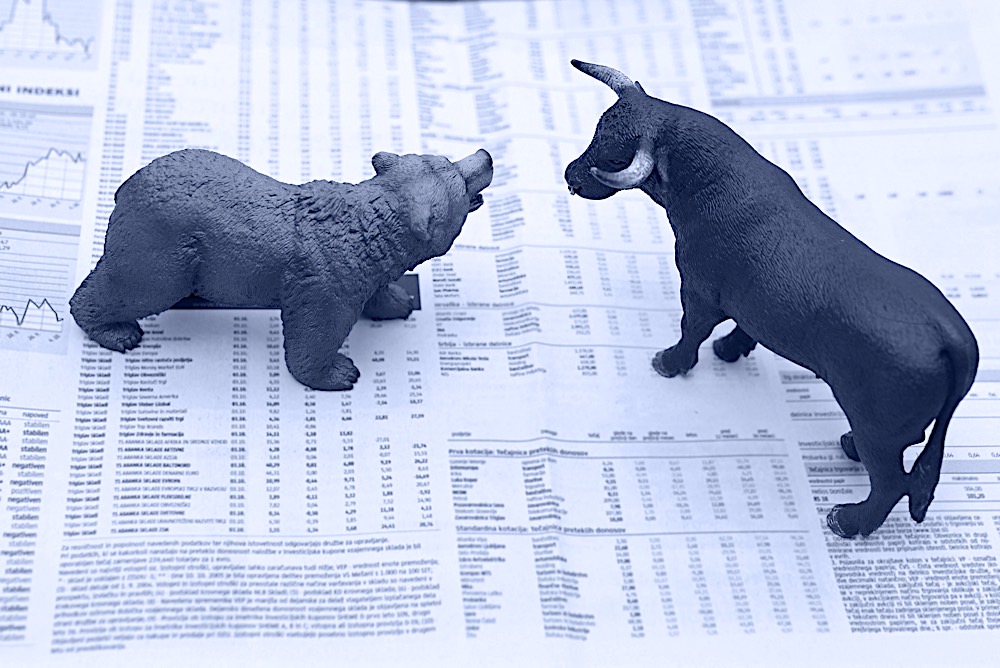Jump To:
The stock market has become synonymous with today’s greatest wealth-building vehicles. Few alternatives, if any, have the same reputation for rewarding patient investors with attractive profit margins. While average returns will vary from year to year, the average stock market return for 10 years is 9.2%, according to Goldman Sachs data for the past 140 years. As a result, Wall Street’s annualized returns have supplemented everything from 401(k)s and real estate to family vacations and new cars, which begs the question: How does the stock market work?
Investors need to know what’s going on behind the scenes. If for nothing else, only a complete understanding of the stock market will help investors optimize strategies and increase their earning potential. Understanding even the most basic fundamentals of Wall Street will teach people how to invest in the stock market with a higher degree of success.
What Is A Stock?
To truly understand what a stock is, investors must first familiarize themselves with where they come from: initial public offerings (IPOs). Otherwise known as an IPO, an initial public offering is exactly what its name suggests: an offer on behalf of private companies to sell individual “pieces” of their business to the public in the form of shares.
When a company “IPOs,” it’s selling shares of itself to the public to raise money for future business prospects. In return for the capital, the company will issue stock on the primary market. Often referred to as shares, stocks represent ownership in a company or corporation. Therefore, when someone buys a stock, they are literally buying a piece of the company that’s proportionate to the number of outstanding shares issued at the IPO.
[ Want to learn what Active vs. Passive Income looks like for stock investors like you? Find out how you can take advantage of Passive Stock Investing in our FREE webinar! ]

Common vs. Preferred Stock
Again, stocks represent ownership in a company that is equal to the number of shares held as a proportion of the company’s total outstanding shares. Therefore, anyone who owns stock in a company technically owns a piece of said company. It is worth noting, however, that the level of involvement investors are granted in the companies they own is contingent on whether their shares are common or preferred.
Stocks may be broken down into two categories: common and preferred stocks. Whether a stock is common or preferred will depend on the issuing company, and how loud of a voice they are willing to give their shareholders.
Common and preferred stocks share a lot of similarities; namely, they both represent ownership in a business and allow investors to profit from growth. The former (common stocks), however, is the most common type of stock, and grants shareholders voting rights. Those who own shares of common stocks are allowed to vote on important decisions within the company. Preferred stocks, on the other hand, do not give their shareholders a voice. Therein lies the biggest differences between common and preferred stocks: one gives shareholders the right to vote, whereas the other doesn’t.
What Is A Stock Exchange?
The New York Stock Exchange (NYSE) is probably the stock exchange most people are familiar with. As a stock exchange, the NYSE is a marketplace where investors buy and sell stocks. Otherwise known as secondary markets, stock exchanges are solely meant to facilitate transactions between investors; businesses and corporations do not participate.
Any attempt to buy or sell shares of a particular company on a stock exchange is made possible by a subsequent investor who is looking to complement the transaction. In other words, when investors sell, they are selling to other investors; when they buy, they are buying from other investors.
In addition to serving as a place where securities are traded, stock exchanges also award participating investors with an inherent sense of security. It was the advent of the stock exchange, in fact, which called for regulations. Buyers and sellers trading on a stock exchange can take solace in the fact that their transactions will process at fair prices and on time. The New York Stock Exchange, for example, is self-regulated and subject to the scrutiny of the Securities and Exchange Commission (SEC).
Pros Of Stock Exchange Listing
“Going public” typically means a business has reached a point where it needs more funds to continue growing. In order to do so, the company is literally forced to sell shares of its business to the public. While some business owners may not appreciate selling shares, there are a number of benefits that coincide with listing on a prominent stock exchange:
-
In the event the company offered private shares to employees privately, they may be able to increase their own liquidity by selling.
-
Issuing more shares will enable a business to raise more money for future endeavors.
-
Public companies can reward employees with stock options, allowing them to attract top-tier talent.
-
Stock exchanges increase exposure for businesses, and inherently drive up visibility and interest.
-
Public companies may use shares to make acquisitions and expand business operations.
Cons Of Stock Exchange Listing
The benefits associated with going public and listing on a stock exchange are well documented. That said, listing does have a few drawbacks, not the least of which include:
-
Listing on an exchange (like the NYSE) coincides with several additional costs, like a number of fees which all revolve around proper compliance and reporting operations.
-
Regulations overseen by the SEC can sometimes impede a company’s ability to conduct business in a particular way.
-
Having to please shareholders each quarter makes it more difficult to exercise long-term plans and strategies.
What Is The Stock Market?
The term “stock market” is typically used to describe any of today’s major stock market indices under one umbrella. The NYSE, the S&P 500, and the Dow Jones Industrial Average (just to name a few) are all individual pieces of the broader stock market. Separately, each index represents its own unique combination of stocks. Together, each index combines to form the whole stock market. More often than not, the term “stock market” is interchangeable with its stock index counterparts. Individual indices simply allow investors to further differentiate between the stocks made available to them.
How Does The Stock Market Work?
The stock market is only as complicated as investors want to make it. While it’s not hard to get intimidated by Wall Street, new investors should know that the fundamental concept of the stock market isn’t all that difficult to comprehend. Not all that different from an auction, the stock market plays host to buyers and sellers, so that they may negotiate prices and facilitate trades.
The process begins when a company decides to make its initial public offering. Investors are then awarded the opportunity to purchase shares of the newly listed business on the primary market (mostly institutional investors), simultaneously raising funds for the company and introducing shares to the stock market.
Once shares are purchased on the primary market, investors may then trade them again on the secondary market (the stock market). Once shares hit the stock market, investors are free to buy and sell stocks amongst each other. It is worth noting, however, that this is just the beginning; the real magic takes place when prices are set.
How Are Stock Market Price Shares Set?
At the same time investors are trading with each other, exchanges are tasked with keeping track of supply and demand for each listed stock. Therein lies the true nature of the stock market: Supply and demand will eventually determine the fair price of each security.
Supply and demand will help buyers formulate a “bid,” or the highest amount they are comfortable paying for a particular security. Sellers, on the other hand, will simultaneously submit an asking price. The two sides rarely agree on the same price (buyers always want it for less and sellers always want more), which is why the price is usually set in the middle by an algorithm. When the two sides match up, the trade is made; the buyer gets their shares, and the seller liquidates their holdings. There are, of course, more moving parts, but this is the simplest way to break down how the stock market works.
Risks Of Investing In The Stock Market
Whether new to the stock market or a 30-year veteran, investors must be aware of the risks associated with investing in stocks. Trading on Wall Street is just like investing in anything else: there is an inherent degree of risk that must be accounted for. Only those who fully accept the risks associated with the stock market will be able to realize their potential. That said, here’s a list of the most common risks investors need to come to terms with:
-
Economic Turmoil: The stock market ebbs and flows off of the economy. When the economy is firing on all cylinders, for example, the stock market typically trends upwards. That said, the economy doesn’t follow a predictable trajectory. If 2020 has taught us anything, it’s that the economy is unpredictable. At any moment the state of the economy can shift and send markets reeling, as it has in the past. It is worth noting, however, that the market goes down faster than it goes up, but it typically goes up more than it goes down.
-
Inflation: Inflation suggests the purchasing power of money is decreased gradually over time. As a result, inflation is a risk to any investment, especially those made over long periods of time. Not unlike every other risk, however, there’s a way to mitigate inflation in the stock market. Investing in REITs (real estate investment trusts), for example, allows investors to put their money into hard assets. Investing in real estate through REITs helps combat inflation because REITs tend to do well at times when inflation is present. Therefore, while inflation remains a very real risk, it’s easy to counter. Only those aware of it, however, will know how to accept it.
-
Value: With share prices fluctuating constantly due to supply and demand, it can be hard to determine a stock’s true value. As a result, it’s entirely possible to overpay for a stock that has “run up” too much based on nothing more than rumors. To be clear, countless scenarios lead to overvalued stock prices. Everything from rumors to acquisitions can increase stock prices beyond their true value. While some increases are justified, many are not. Investors caught paying too much for stocks that don’t warrant the price jump could find themselves with a depreciating asset.
-
Underperformance: Not all stocks are created equal. Some companies are objectively better than others; it’s that simple. Therefore, investing in a poor company is a real risk investors need to be aware of. Investing in a company that underperforms can result in the loss of capital. Not only that, but the risk is compounded when the underperformance of a respective stock is compared to a market that has proven to increase more than 9.0% every decade. When investors buy an underperforming stock, they not only lose equity in their security, but they miss out on the overall performance of the market.
-
Uniformity: A properly diversified portfolio is the safest way to mitigate risk. Consequently, the easiest way to welcome risk is to invest in a single stock or industry. “Putting all your eggs in one basket” means your portfolio is susceptible to even the slightest market and industry shifts. A lack of diversity could very well end up being the downfall of an entire portfolio. Instead, diversify your holdings and create a hedge to protect against insignificant market events.
Benefits Of Investing In The Stock Market
Now that the risks of investing in the stock market are out of the way, it is time to dive into the benefits of investing in the stock market:
-
Economic Tailwinds: While a poor economy may serve as a headwind for stocks, a healthy economy will provide significant tailwinds. Stocks thrive in an expanding economy, which bodes well for investors who get in at the right time. When the economy is doing well, the companies serving as its foundation are too, which tends to increase their share prices and the value of investors’ portfolios.
-
Beat Inflation: Again, inflation is like a tax everyone must pay. Anyone who keeps money in a savings account, for example, may actually lose money to inflation over time. Those who invest in stocks, however, are more likely to offset and even beat inflation. With the stock market growing by as much as 9.0% every decade, inflation becomes much less of a drain on investors’ net worth.
-
Growth Stocks: Growth stocks award investors with the opportunity to increase their equity in a particular company. In growing their equity, investors will see their returns increase over time, which is the primary reason most people invest in the first place.
-
Dividend Stocks: Outside of growth stocks, dividend stocks offer investors another way to increase their annual returns. As their names suggest, dividend stocks pay dividends to their shareholders on a predetermined schedule. The income received from dividend stocks is treated as income and can supplement investors’ entire income if done correctly.
-
Liquidity: While most investors will argue stocks are a long-term play, it is possible to liquidate holdings in a moment’s notice. Investors who need access to their money can liquidate their holdings fast, and sometimes have access to it immediately.
Summary
How does the stock market work? Few questions may result in more polarizing answers. Some answers will confuse even the most seasoned investors, whereas others will over-simplify Wall Street. In reality, however, the stock market is as complicated or as simple as you want to make it.
Instead of making things hard on yourself, it is better to take a step back and break down the stock market into easy-to-digest bits of information, which we have attempted to do in this article. In doing so, new investors will have a better idea of how the stock market works, and have a foundation to build off of moving forward. Hopefully, instead of asking themselves “how does the stock market work,” prospective investors can learn from participating.
Ready to cashflow your investment portfolio?
Find out how Andy Tanner uses the stock market to generate cash flow with safe, steady investing strategies – no matter what is happening in the overall economy.
Register here for Instant Access to Learn How To Start Stock Investing For Cash Flow, and get started learning how to start a successful investment portfolio today!


